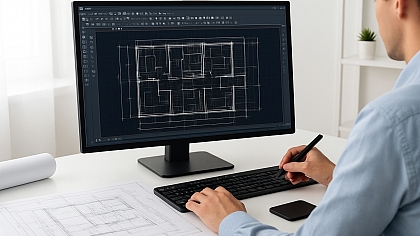
How to Choose Estimating & Project Management Software
For Construction Projects
Suppose your bid time is getting over tomorrow, and you are stuck in a spreadsheet, doing calculations. Too many tabs and a short time. That’s where most of us realize we need help, and it is where Construction Estimating Services come in.
If you’ve been in construction long enough, you already know this: jobs are getting faster, clients are getting tougher, and mistakes are getting costlier. Additionally, bids today aren’t just estimates; they’re proof of your professionalism, and one small error can cost thousands of dollars.
Many contractors think about using construction estimating and project management software. But they are complicated, too, if you don't have expertise or knowledge about using them.
Let’s talk like we're two sitting at the table, coffee in hand, sorting these things out step by step.
Why Old Methods Don’t Work Now
Many contractors grew up doing bids on paper or in Excel. You’d measure from the drawings, punch in the numbers, and hope the totals were right. It worked for years. But today, jobs move too fast. There are too many files, emails, revisions, and change orders. When you work like that, it’s common to miss things.
Let me tell you about a real guy I know, Mike, a GC in Texas. He handled everything in Excel and ran five jobs at once, and he was good at it. Until one day, a $1.5 million project went sideways. He missed a price update from a subcontractor and lost $20,000 in profit. Why? Because one estimate didn’t get updated across his sheets.
He didn’t lose that money because he didn’t know his stuff. However, he lost it because his tools couldn’t keep up. That’s when he started looking into the project and estimating software. And like most contractors, he realized, it’s about saving your time and increasing your profit.
The Features Of Reliable Construction Estimating & Management Software
1. Save Your Time
If the software can't make your job easier, it is not worth it because the system must help you create bids faster, track updates, and highlight mistakes before they become a major issue.
2. Keep Everything in One Place
No more searching through old emails or losing track of versions. A sound system keeps your drawings, notes, and costs in one spot. Everyone on your team sees the same numbers—no confusion, no late updates.
3. Work with What You Already Use
If your system can’t connect with your current tools, like QuickBooks, Procore, or email, it’ll just make things harder. So, always check if the software plays nice with your setup.
4. Easy for Your Team to Use
If your supervisor or estimator can’t figure it out in a day, skip it. Construction estimating and management software should be simple, requiring no long training and giving no headaches.
How To Estimate & Manage Construction Like a Master?
The top and well-known Construction Estimating Companies never pick the flashiest tools. However, they pick the ones that fit their workflow.
Here are some examples for better understanding.
- A small subcontractor wanted a system that helped them do bids faster. They didn’t care about dashboards. They just needed speed.
- A large GC needed one platform that connected estimating with scheduling, so they didn’t have to re-enter numbers twice.
- A concrete company wanted software that worked offline because they didn’t have Wi-Fi on-site.
All examples give data on different jobs and different needs, but the same goal: using the tools that make work smoother.
The Need For a Better Software System
You can’t build trust if your numbers don’t add up. Clients and lenders today want transparency. They want to see how you got your numbers. They’re not asking to annoy you; they just want to know they’re making a safe bet.
The right software helps you show that. When you can click a button and show every cost line, change order, and note, people trust you more.
And that trust gets you more work. Because when you look organized and confident, clients remember that. They don’t just hire you for your bid; they hire you for peace of mind.
How Estimating and Project Management Should Work Together

This is where most people get it wrong. They think estimating and project management are two separate things. But they’re really two sides of the same coin.
You win a bid based on your estimate. Then you have to deliver that job based on those same numbers. If your estimating software and project management tool don’t talk to each other, mistakes happen fast.
For example:
You estimate 500 yards of concrete. Project management never gets that note, and the sub pours 480. Who pays for that gap? You do.
But if your software connects both stages, the numbers flow automatically. No double entry. No missed notes. That’s how smart contractors work now, with everything linked from bid to build.
Cheap Tools vs. Smart Investments
Here’s something most people don’t think about: bad software is expensive not just in dollars, but in time and frustration. Say you save $50 a month using cheap tools. But they cost you 3 hours every week fixing issues, which means 150 hours yearly are wasted.
Sound tools don’t just cost money; they help you make money. They help you avoid missed items, speed up bids, and track jobs more clearly. So, don’t look for the cheapest software—look for the one that helps you avoid mistakes.
Guide to Choose the Right Software
1. Map Your Process
Write down how your bids flow right now, from drawings to final submittal. Where are the delays? Where do errors happen? That’s what your new software needs to fix.
2. Make a Must-Have List
List your top five needs.
For example:
- Quick takeoffs
- Shared access
- Easy reports
- Cloud storage
- Budget tracking
Stick to that list. Don’t get distracted by other features.
3. Test Two Options
Run a live job through both. If your team likes one better, you’ll know right away. Don’t buy before testing.
4. Ask About Support
Good vendors pick up the phone when you call. Bad ones send you to a chatbot. That alone can tell you who’s worth your money.
5. Start with One Project
Don’t move your whole company at once. Try one project first, fix the kinks, and then roll it out.
How to Ensure You Pick the Right Software
You’ll know it’s working when:
- You stop chasing old files.
- Bids get out faster.
- Team members stop asking for updates; they already have them.
- You can show a client exactly where every number came from.
- You sleep better before bid day.
What We’ve Seen Work Best for Contractors
- Cloud-based software: So you can check updates anywhere, even from your truck.
- Automatic pricing updates: It keeps your material costs accurate.
- Built-in scheduling: It links your estimate to your job timeline.
- Mobile access: It facilitates quick checks in the field.
- Version control: It means no more losing track of “final-final” files.
If your software includes these features, you are already ahead of 80% of your competitors.
Simply put, no tool will fix a broken process. But the right tool makes it easier to stay on the same page. It keeps everyone connected and accountable. It cuts confusion and gives you the confidence that your numbers are right. And when you feel confident, you work better.
How Can You Start Today?
Here’s what you can do today:
- Write down your biggest headache in estimating or project tracking.
- Find two tools that claim to solve it.
- Book a demo or try a free trial.
- Get your estimator and project manager to test them.
- Pick what your team likes, not what the ad promises.
So, you must have understood that choosing construction estimating and management software is not about going modern, but about getting updated with new technologies. This approach will help you make your bids faster with accurate elements while ensuring everyone is on the same page. Simply put, you can focus on your core job, which is building, not playing with numbers.
Hence, keep all the points in mind when you are thinking about buying software for construction estimation and management. And if you need assistance connecting your layouts and designs with estimates, engage a CAD Drafter. They bridge the gap between plans and prices, turning your ideas into accurate, buildable numbers.










